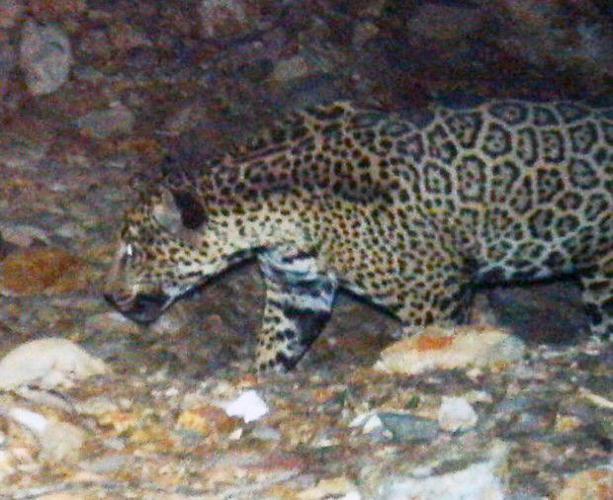The proposed Rosemont Mine is likely to kill, harm or harass this country's only known wild jaguar, the U.S. Fish and Wildlife Service says.
But that won't matter much, the agency adds - at least not in terms of jeopardizing the jaguar as a species or destroying its prime habitat.
That view comes from a new draft biological opinion on the mine that the service finished recently, and that the Star obtained this week.
The opinion, if it's finalized, will be a key document needed for approval of the highly controversial project.
But it's already come under criticism from the Tucson-based environmental group whose litigation forced the wildlife service to list the jaguar as endangered 17 years ago.
The wildlife service's view rests on the presence of 30,000 jaguars in Mexico, Central America and South America, and the service's opinion that the adult male jaguar known to be living near the proposed mine near Tucson is the only one likely to be hurt by it.
It also rests on the existence of hundreds of thousands of acres of proposed jaguar critical habitat in Southern Arizona that the mine wouldn't touch.
"Although abundance and population trends for the jaguar rangewide are not well known, and populations throughout their range continue to be at risk, the Rosemont Copper mine will not have an appreciable impact" on the entire population or its U.S. habitat, the opinion says.
But "to say that we have jaguars in place A in one country so we don't need them in place B in this country is contrary to the Endangered Species Act," counters Michael Robinson, an activist for the Tucson-based Center for Biological Diversity. "They are essentially writing off this one jaguar. The bottom line is that this is an endangered species that under law and ethics should be recovered."
The center's lawsuits have prodded the wildlife service to list the animal, to propose designating jaguar habitat and to prepare a recovery plan - all over the agency's original opposition.
The wildlife service's 418-page opinion also says the mine won't jeopardize eight other endangered and threatened species known to live on or near thousands of acres that would be disturbed for the mine in the Santa Rita Mountains southeast of Tucson. That's despite the fact that a "reasonable certainty" exists of inadvertent harm or death to members of five species total including the jaguar, the service said.
Mitigation measures
Backing these conclusions, the service cites planned land purchases, monitoring plans, non-native species removal programs and numerous other mitigation measures that the mining company, Rosemont Copper, has committed to.
Before the opinion becomes final, it must be commented upon by a group of local, state and federal agencies by the end of this month. Then it must be signed off on by the U.S. Forest Service when it decides on the mine. Regardless of the final decision, one side or another in this hot dispute is likely to sue to overturn it.
"We are pleased to see that the biological opinion confirms that there is no jeopardy to any of the listed species. We appreciate the agencies' efforts and their staffs' thorough and credible work to complete all the detailed and comprehensive analysis that went into this document," said Kathy Arnold, Rosemont Copper's vice president for environmental and regulatory affairs.
Rick Grinnell, vice president of the pro-Rosemont Southern Arizona Business Coalition, said this biological opinion shows the mine's overall approval process is working.
"Whatever mitigation will occur will happen between Rosemont and the Forest Service, and the public will be aware of details down the road," Grinnell said.
On the jaguar, the wildlife service predicts that one will be a victim of "take," a legal term meaning to kill, harm, wound, capture or harass an endangered species. That would be due to construction, operation and restoration of the open-pit mine and associated roads that disrupt normal behavior patterns including breeding, feeding or sheltering.
But this "take" isn't likely to appreciably reduce the species' chances of recovery and survival, since the jaguar ranges south to Brazil, the opinion said.
As for habitat, the mine likely would impact no more than 19,626 acres of proposed critical habitat, the opinion said. That's less than 6 percent of the 343,000 acres of Unit 3 of the proposed critical habitat that covers the Santa Rita, Huachuca and Patagonia mountains and 2.3 percent of all critical habitat proposed for the jaguar in the United States.
The Mexico connection
Proposed conservation measures for the mine would protect 1,727 acres, partially offsetting the mine's impacts, the opinion said.
To prove the mine would illegally destroy critical habitat, it would have to be shown that the jaguar would be unable to traverse a constricted area of that habitat near the site and that smaller sections of critical habitat would be inaccessible to jaguars and remove their connectivity to Mexico - and those arguments can't be justified, the opinion said.
The Center for Biological Diversity's Robinson, however, said it's premature for the wildlife service to say that the jaguar habitat damaged by this mine isn't significant for recovery because it has not yet established formal jaguar recovery goals. While the jaguar's recovery certainly depends on northern Mexico, having a more robust U.S. jaguar population could prove important in saving the Mexican population, Robinson said.
"Their overall problem is the same one that has hurt them in court before - they have always sought to marginalize jaguars in the United States," he said.
On StarNet: Read more environmental news at azstarnet.com/environment
Contact reporter Tony Davis at tdavis@azstarnet.com or 806-7746. Follow Davis on Twitter@tonydavis987.





